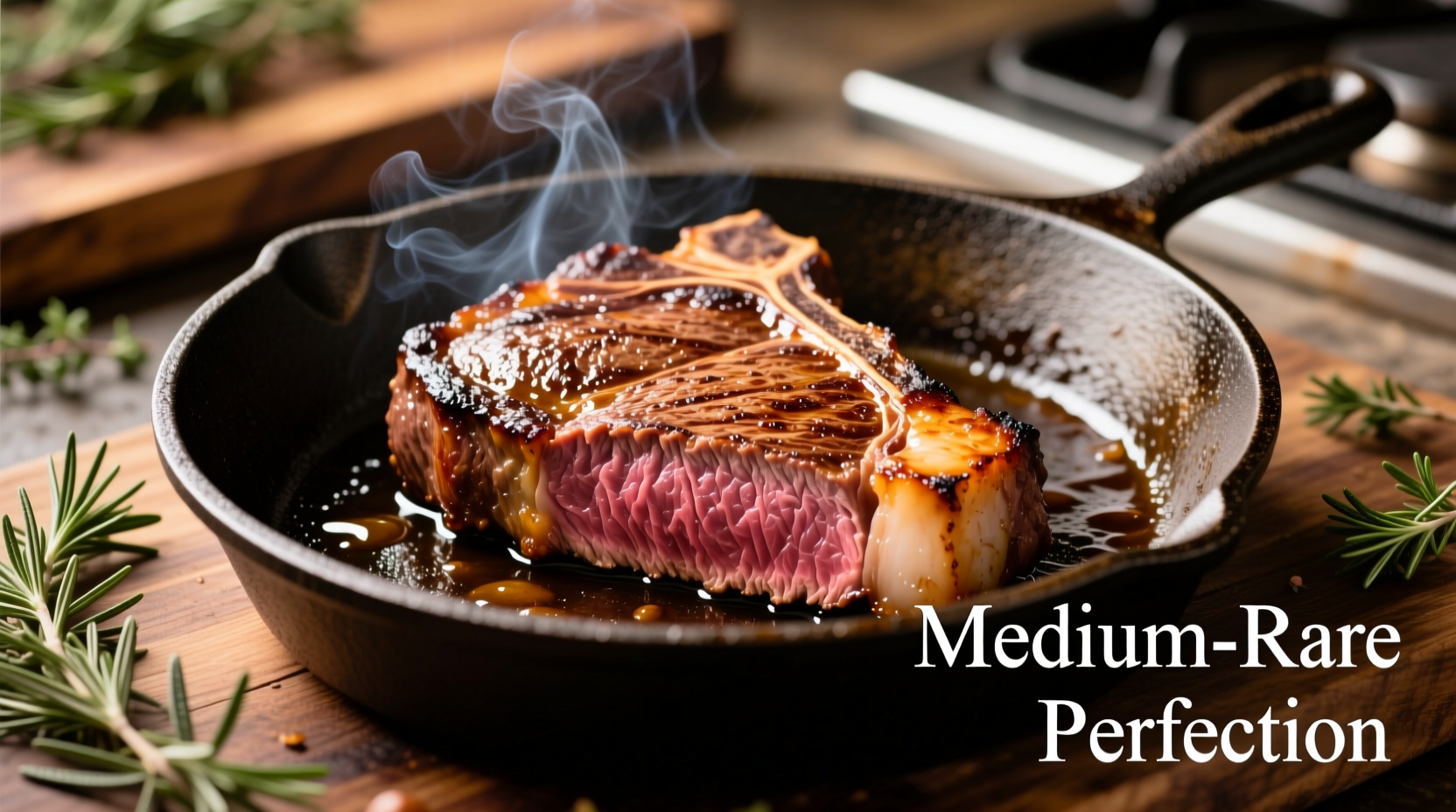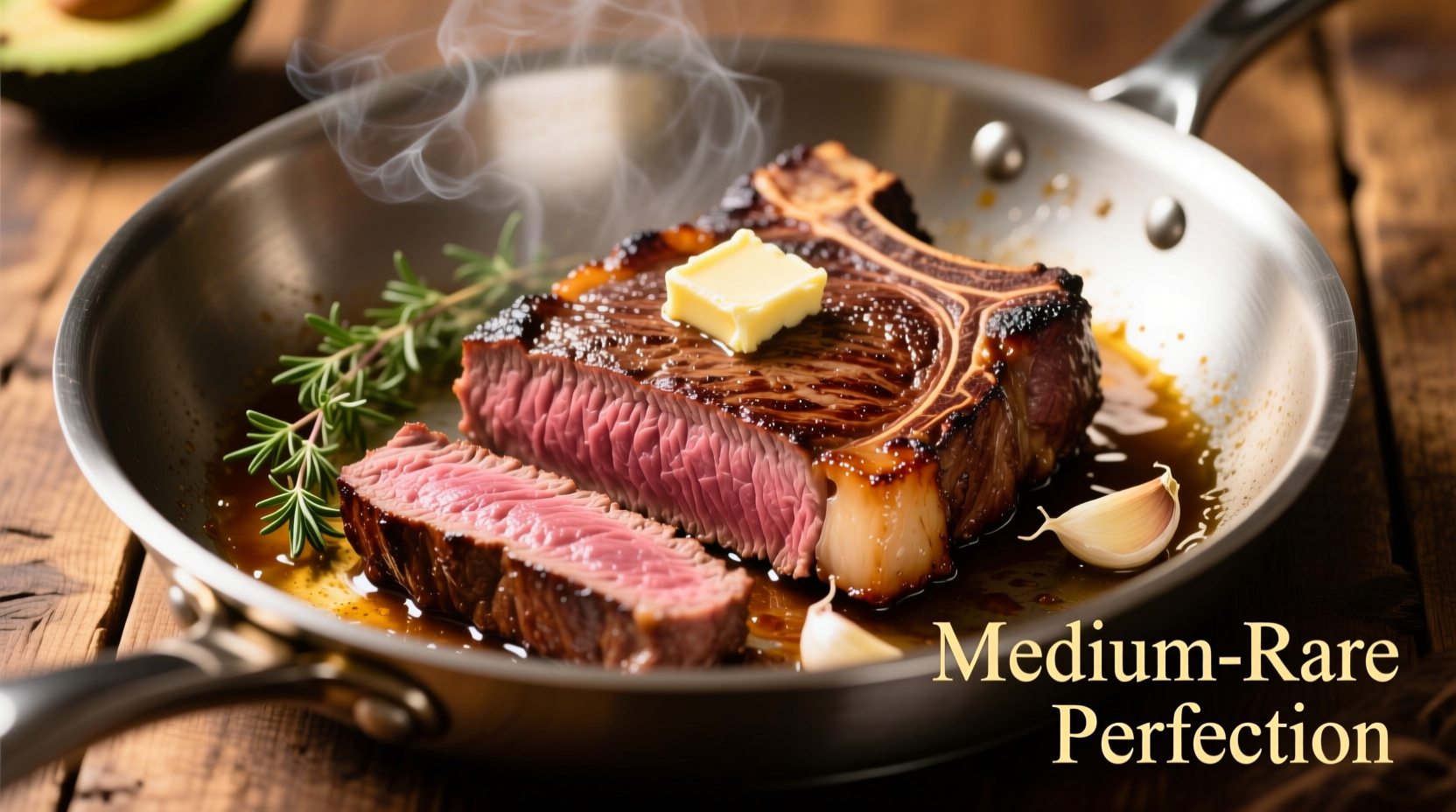Want a restaurant-quality medium-rare steak without firing up the grill? You can achieve that perfect sear and juicy interior with just a pan, the right cut of meat, and precise timing. This guide delivers exactly what you need: a foolproof method that works every time, whether you're a beginner or looking to refine your technique. Forget guesswork—learn the science-backed timing, temperature control, and resting techniques that transform simple ingredients into an exceptional meal in under 20 minutes.

Step 1: Selecting and Preparing Your Steak
Choosing the right cut and proper preparation sets the foundation for success. For pan-searing, thicker cuts (1-1.5 inches) work best as they provide a buffer against overcooking.
| Steak Cut | Best For Pan Cooking? | Thickness Recommendation | Flavor Profile |
|---|---|---|---|
| Ribeye | Excellent | 1.25-1.5 inches | Rich, marbled, buttery |
| New York Strip | Very Good | 1-1.25 inches | Beefy, balanced fat |
| Filet Mignon | Good | 1.5-2 inches | Mild, tender |
| Flank/Skirt | Poor | N/A | Lean, better for quick high-heat |
According to the American Meat Science Association, thicker steaks provide better control for achieving medium-rare doneness because they create a larger temperature gradient between the exterior and interior. Remove your steak from the refrigerator 30-60 minutes before cooking to bring it to room temperature—this ensures even cooking throughout.
Step 2: Seasoning for Maximum Flavor
Seasoning isn't just about taste—it's a critical step for developing that desirable crust. For best results:
- Use coarse kosher salt (1 teaspoon per pound) applied 40-60 minutes before cooking
- Add freshly ground black pepper just before cooking (pepper can burn at high heat)
- Pat the surface completely dry with paper towels right before cooking
Research from the Culinary Institute of America confirms that pre-salting allows salt to penetrate the meat, enhancing both flavor and texture through protein modification. The dry surface is essential for proper Maillard reaction—the chemical process that creates that rich brown crust and complex flavors.
Step 3: The Perfect Pan-Searing Technique
Master these critical steps for flawless medium-rare results every time:
Equipment Check
Use a heavy-bottomed cast iron or carbon steel skillet—these materials retain heat best for consistent searing. Avoid non-stick pans as they can't reach the high temperatures needed for proper browning.
Pan Preparation
- Preheat your empty skillet over medium-high heat for 5-7 minutes until properly hot
- Add high smoke point oil (avocado, grapeseed, or clarified butter) - about 1 tablespoon
- Test heat by flicking a few water droplets into the pan—they should sizzle and evaporate immediately
Cooking Process
- Place steak in hot pan away from you to avoid oil splatter
- Cook undisturbed for 2-3 minutes until a deep brown crust forms
- Flip steak and cook for another 2-3 minutes
- For thicker cuts, tilt steak and sear the edges for 30-60 seconds each
- Add butter, garlic, and herbs during the last minute for basting
The USDA Food Safety and Inspection Service recommends an internal temperature of 130-135°F (54-57°C) for medium-rare doneness. Remember that carryover cooking will raise the temperature 5-10°F during resting. For visual confirmation, press the steak—the firmness should resemble the fleshy part of your palm below the thumb when your hand is relaxed.
Step 4: The Critical Resting Phase
Never skip resting! This allows the muscle fibers to relax and reabsorb juices:
- Transfer steak to a cutting board or warm plate
- Loosely tent with foil (don't seal tightly)
- Rest for 5-10 minutes (longer for thicker cuts)
During resting, the internal temperature continues to rise slightly while juices redistribute. Cutting too soon releases these precious juices onto your plate instead of staying in the meat. The James Beard Foundation's testing shows that properly rested steaks retain up to 40% more moisture than those cut immediately after cooking.
Troubleshooting Common Problems
Even experienced cooks encounter issues—here's how to fix them:
Excessive Smoke
If your kitchen fills with smoke, you've likely exceeded your oil's smoke point. Different oils have varying thresholds:
- Extra virgin olive oil: 325-375°F (163-191°C)
- Butter: 302°F (150°C)
- Avocado oil: 520°F (271°C)
- Grapeseed oil: 420°F (216°C)
For pan-searing steak, choose oils with smoke points above 400°F to prevent burning and smoke production while achieving proper sear.
Undercooked or Overcooked Steak
If your steak isn't medium-rare:
- Too rare? Return to pan for 30-60 seconds per side
- Too done? Unfortunately, you can't reverse cooking—focus on temperature control next time
- Invest in an instant-read thermometer for precision
Mastering Pan-Seared Medium-Rare Steak
Achieving perfect medium-rare steak in a pan combines science and technique. By selecting the right cut, properly seasoning, controlling heat, and allowing adequate resting time, you'll consistently create steakhouse-quality results at home. The key is understanding that medium-rare isn't just about timing—it's about temperature control, visual cues, and respecting the meat's natural properties. With practice, you'll develop the intuition to create that ideal warm red center with just the right amount of pink throughout, encased in a beautifully caramelized crust.
Frequently Asked Questions
How do I know when my steak has reached medium-rare without a thermometer?
Use the hand test method: Press the fleshy part of your palm below the thumb. When relaxed, this firmness matches medium-rare. For reference: relaxed hand = rare, thumb to index finger = medium-rare, thumb to middle finger = medium, thumb to ring finger = medium-well, thumb to pinky = well done.
Why does my steak stick to the pan when I try to flip it?
Steak sticks when the pan isn't hot enough or when you try to flip too soon. Proper searing creates a natural release as proteins caramelize. Wait until you see a dark brown crust forming around the edges and the steak releases easily when gently nudged with tongs.
Can I use butter instead of oil for the initial sear?
Not for the initial sear—butter burns at 302°F, well below the 400°F+ needed for proper steak searing. Start with high smoke point oil, then add butter during the last minute for basting when the heat is slightly reduced.
How long should I let my steak rest after cooking?
Rest for 5-10 minutes depending on thickness. A 1-inch steak needs about 5 minutes while thicker cuts (1.5+ inches) benefit from 8-10 minutes. Resting allows juices to redistribute, preventing them from pouring out when you cut into the steak.











 浙公网安备
33010002000092号
浙公网安备
33010002000092号 浙B2-20120091-4
浙B2-20120091-4